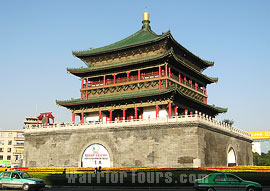- Big Wild Goose Pagoda & Tang Dynasty Palace
- Bell/Drum Tower & Daxingshan Temple
- City Wall
- Forest of Stone Steles Museum & Banpo Museum
- Great Mosque
- Huaqing Hot Springs & Xingjiao Temple
- Mausoleum of the First Qin Emperor
- Mausoleum of Western Han Emperor Liu Qi
- Terracotta Warriors
- Shaanxi History Museum
- Small Wild Goose Pagoda
- Famen Temple & Xianyang Museum
- Maoling Mausoleum & Tomb of Huo Qubing
- Mt. Huashan
- Qian Mausoleum & Zhaoling Mausoleum
Bell/Drum Tower & Daxingshan Temple

![]() Bell Tower
Bell Tower
The Bell Tower, a remarkable symbol of Xian, is located in the center of city where the four main streets intersect. The 36-meter (118 ft) high tower was built on a square base with a length of 35.5 meters (116.4 ft) in each side. Covering an area of about 1377.4 sq meters (0.34 acres), the Bell Tower is the largest and also the best preserved one among the existing bell towers in China.
The Bell Tower was originally built in 1384 by Emperor Zhu Yuanzhang of the Ming Dynasty (1368-1644). At that time, the Bell Tower was located a block west of its current position where was opposite to the Drum Tower. In 1582, it was moved to the current site. The wooden tower has two stories with three layers of eaves, and visitors can climb the stairs inside. The original bell that hung in the tower was created during the Tang Dynasty (618-907) and is now preserved in the Forest of Stone Steles Museum. A copy of the bell is now situated in the northwest corner of the Bell Tower. There are also music performances performed on the first floor. Performers in traditional costume play Tang Dynasty music with traditional Chinese musical instruments. Many cultural relics such as Chinese painting and calligraphy are preserved in the second floor. Visitors also can overlook the view of Xian City in the corridors of second floor.

![]() Drum Tower
Drum Tower
To the northwest of the Bell Tower is the Drum tower, another symbol of ancient Xian, which stands on the diagonal of the Bell Tower and Drum Tower Square. Four years older than the Bell Tower, the Drum Tower was also built during the Ming Dynasty. A huge drum was housed in the tower and struck every evening. Covering an area of 1924 sq meters (0.48 acres) and with a height of 33 meters (108.3 ft), the Drum Tower is also a two-storey building with three layers of eaves. The base of the tower is 52.6 meters (172.6 ft) long, 38 meters wide (124.7 ft) and 7.7 meters (25.3 ft) high. Under the brick-made base a busy road extends. Visitors can also climb the tower to appreciate the beautiful landscape of Xian.
| Admission Fee: | Bell Tower: CNY 27 Drum Tower: CNY 27 Through ticket for Bell Tower and Drum Tower: CNY 30 |
| Opening Hours: | 08:30-21:30 (Bell Tower) 08:30-18:00 (Drum Tower) |
![]() Daxingshan Temple
Daxingshan Temple
Daxingshan Temple once was the greatest Buddhist establishment of the Sui and Tang Dynasties, but since the tenth century it has been destroyed and rebuilt several times.
The latest reconstruction was built in 1956. Today, it has been turned into a small, quiet and charming park. The main buildings have been repainted and a handful of monks live and worship there.
The history of this temple can be traced back to the third century, when its original name was Zunshan Temple. During the Sui Dynasty, it was rebuilt and was given its present name. Since then, it gradually became the headquarters of an order with a network of 45 prefectural temples, which were all established by Yang Qian, the founder of the Sui Dynasty. During the Tang Dynasty, it became a great center of Buddhist art and learning. However, during the Buddhist persecution of 841-845, most of the buildings were destroyed and even ones that survived also disappeared by the end of the Tang. The temple was rebuilt in the Ming and again restored in 1785 by an expert on Tang Dynasty Chang'an called Bi Yuan (1730-97). After its reconstruction in 1956 it was used by a Community of Lamaist monks until the Cultural Revolution (1966-76). Today it houses the Xian Buddhist Association.
The temple and Xinfeng Park are located south of the Small Wild Goose Pagoda on a small street called Xingshan Si jie, behind the open market of Xiaozhai.
| Admission Fee: | Free |

